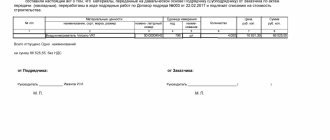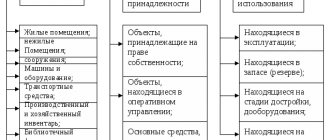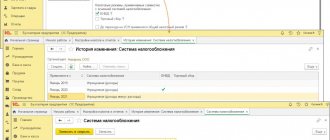4,50
5
| Reviews: | 5 | Views: | 40919 |
| Votes: | 4 | Updated: | 20.01.2015 |
File type .doc (Microsoft Word 97)
Document type: Act
?
Ask a question Remember: Contract-Yurist.Ru - there are a bunch of sample documents here
| __________________________________ (organization) | I affirm: ____________________________ ____________________________ "____"___________ 20__ |
Regulatory framework for developing write-off standards
The development and approval of standards for the write-off of building materials for a specific enterprise should be based on basic rules and regulations. The main working documents are:
- SNiP 82-01-95 “Development and application of norms and standards for the consumption of material resources in construction”;
- RDS 82-201-96 “Rules for the development of standards for material consumption in construction.”
SNiP 82-01-95 establishes more general provisions for rationing materials in construction, RDS 82-201-96 complements and specifies most of the aspects, and also contains examples of calculations.
The basic quantities of consumption and type of materials are determined by the requirements for the construction project. For example, the composition of the concrete used may differ for an industrial workshop building and for a residential building. In this aspect, one should be guided by GOST and SanPiN standards for construction, as well as the opinions of technical experts.
There are other types of specific documents involved in standardization:
- GESN - state elemental estimate standards. They indicate the permissible estimated values of material consumption for specific types of construction work;
- MDS - methodological documents in construction. They contain instructions for the use of GESN.
The main body issuing the regulatory documents listed above is the State Construction Committee of Russia. Although other executive bodies (for example, the Ministry of Health), research institutions and even enterprises in the construction industry are usually involved in the development.
ConsultantPlus experts tell you in detail how to take into account building materials. Get free demo access to K+ and go to the Ready Solution to find out all the details of this procedure.
Accompanying documents
The entire package of documentation for the write-off of building materials in production consists mainly of relationships with suppliers and their behavior under the supply agreement. But the basics are a must for any construction venture.
These are documents such as:
- the standard for consumption of construction raw materials for specific construction approved by the director of the enterprise;
- working estimate;
- log of work performed;
- reporting summary of the actual expenditure of provided resources indicating the difference with the established standards.
For 2021, in Russia, companies have the right to set their own standards for the sale of inventory, but they should not contradict the requirements of the State Register of Inventory. Therefore, it is best to use the standards of the M29 form together with the standard current instructions for its maintenance.
The form can and should be supplemented and adapted to a specific case individually, but two chapters should always be in it:
- estimated volume of resources and number of completed works;
- reconciliation of calculated volumes with actual consumption within the framework of established standard standards.
The technical department is responsible for the first section, and the foremen and site managers are responsible for the second.
The procedure and content of the process of rationing building materials
The process of standardization in construction consists of regulating the use of building materials during the execution of work. The main stages of standardization are:
- Analysis of the conditions under which construction work will take place. At this stage the following is carried out:
- final selection of materials (taking into account the requirements of technical design documentation, GOST and SNiP);
- organization of the work process;
- definition of a unit of work;
- determination of consumables to complete a unit of work.
IMPORTANT! A unit of construction product is a component of the construction flow. Construction flow - uniform, continuous execution of construction work (progress). When standardizing, the following can be taken as a unit:
- separate area of work;
- part of an object under construction (for example, a foundation or a wall);
- one entire object or a group of homogeneous objects (for example, the construction phase of a cottage community of 20 standard houses);
- takeover is a private flow that covers several elements of the main one (for example, custom finishing of part of the apartments in a new building).
- Determination of the standard consumption of each building material per unit of work. According to RDS 82-201-96, cost standards can be:
- Enlarged - by complex of works. They are used at the design stage to select technological solutions.
IMPORTANT! Integrated standards cannot be used to write off building materials.
- Averaged - according to estimate documentation. Needed to determine the total amount of resources required for construction.
IMPORTANT! Average standards cannot be used to control the actual write-off of materials, as well as for payments for construction work (between customers and contractors).
- Elemental - consumption for the selected unit of construction work. They are the ones that should be used when calculating and approving standards for write-off of materials during construction work (as well as for settlements between customers and contractors).
- Monitoring compliance with consumption standards when performing work and adjusting standards if necessary. Here we should mention another specific thing in the construction process - normal.
Normal is an indicator or characteristic that most fully corresponds to the technical process. Determined taking into account a set of parameters. For standard work, there are usually already developed standards that can be relied upon when developing write-off standards.
The main principle of rationing is the unity of the normal and the standard. If the consumption according to the established standard leads to a deviation from the norm, the standard needs to be revised.
EXPLANATIONS from ConsultantPlus: From January 1, 2021, FAS 5/2019 “Inventories” is in effect, approved by Order of the Ministry of Finance of Russia dated November 15, 2019 N 180n. At the same time, PBU 5/01 and Guidelines for accounting of inventories are no longer valid. You can start applying the Standard earlier. For details, see the review from ConsultantPlus. If you do not have access to the K+ system, get a trial online access for free.
How to draw up an order to write off inventories - form and sample
The write-off procedure consists of several stages, among which a significant place is occupied by the manager’s order to appoint a commission tasked with carrying out the necessary activities.
If necessary, the document can contain the commission’s work regulations. However, usually the operating procedure of such a formation is established at the beginning of the company’s work, so as not to schedule it every time.
When choosing exactly this option, the next order remains to reflect: the name of the company, the serial number and date of the order, the purpose of forming the commission, its personal composition and, finally, the signature of the director.
You can view a sample order for write-off of inventories on our website.
Methods for developing elemental write-off standards
Write-off rates per unit of production are determined by consumption rates per unit of work operation.
Calculation formula:
N = ni1Ki1 + ni2Ki2 +… + niiKii,
Where:
N is the write-off rate per unit of construction product;
ni is the consumption rate for a working operation;
Ki is a coefficient that takes into account the share of a unit of work operation in the total volume of construction products;
Ki= Elemental unit of production / Enlarged unit of production.
Detailed rules for calculating, presenting and rounding numerical values of norms for write-off of building materials are presented in clause 5 of RDS 82-201-96.
To set elemental standards per unit of work operation, the following methods are used:
- Production - consists of observing a similar operation directly at a construction site and measuring the volume of work performed and materials spent on it. Most often used for materials that have hard-to-remove losses (we will talk about this in more detail later).
- Laboratory - observations and measurements are made in specially created conditions. It is usually used in cases where it is necessary to determine the influence on the process of a factor (for example, the density of sand from different batches) or a set of factors (for example, the influence of different weather conditions on a new type of material).
- Calculation and analytical - consists of carrying out theoretical calculations based on available statistical data on similar designs and technologies.
IMPORTANT! When taking measurements, several approaches must be performed (at least 5 according to RDS 82-201-96). For different categories of building materials, a different number of approaches can be established to bring data to an acceptable error. Tables of the dependence of approaches on the category of materials are presented in the RDS.
Form M-29. Report on materials consumption in construction
To date, there is no unified form for reporting and recording the volumes of construction materials expended on construction sites. Previously, a generally applicable and mandatory document was the M-29 form, which related to the primary documentation of construction companies. However, despite the abolition of the use of a single model of this document since 2013, it is still widely distributed in its previous form. Based on it, building materials are written off for the cost of work. The same document allows you to compare data on pre-planned expenses based on standards and actual consumption of materials.
The main responsibility for filling out the M-29 form falls within the competence of the foremen or heads of construction sites, who, over a period of time, enter into it all the required information regarding the actual use of building materials. Information on material consumption standards is entered into by employees of production and technical departments. And the report on materials consumption is checked and signed by accounting specialists and the head of the construction organization.
In this case, the document must be checked monthly in order to promptly identify violations of material consumption standards and prevent them in the future.
For each individual construction project, its own report is filled out. The document may have additional sheets, so its size is unlimited.
The basis for drawing up the report are generally approved and local norms for the consumption of building materials, the “primary” material accounting, information from the logbook of work performed, etc.
Drawing up standards for write-off of building materials
The obtained measurement results are analyzed to determine the base value of the norm. After this, you can begin to draw up standards for the write-off (consumption) of materials for the operation. Usually the result is presented in a table that indicates the unit of the work operation, the name of the material, its unit of measurement and the standard.
Example (based on RDS 82-201-96)
Unit of work operation: laying 1 m3 of a wall made of ceramic stone facing with sand-lime brick.
Process technology:
- Making a bed out of mortar.
- Laying ceramic stones.
- Cladding with silicate bricks.
According to the measurement results and calculations:
| Material | Unit | Consumption rate per 1 m3 of wall with an average architectural design of 2 bricks, with an opening of 20% |
| Ceramic stone 250 × 120 × 65 mm | PC. | 212 |
| Single silicate brick | PC. | 107 |
| Cement-lime mortar | m3 | 0,24 |
Next, using the above formula, you can calculate the required amount of materials, for example, for a wall with a design cubic capacity of 500 m3.
The rules for calculating the volumes of building structures also have their own specifics, set out in detail in the RDS.
Average cost estimate
This method contains two options for calculating the cost of material.
Option 1 – weighted assessment:
To determine the weighted score, do the following:
- the cost of a group of materials at the beginning of the month and those purchased before the end of this month is calculated; the quantity of materials of the same group for the reporting period is calculated (the sum of the balance at the beginning of the month and the quantity purchased during the month); the resulting cost is divided by the number of materials.
Option 2 – sliding assessment:
The rolling estimate is the actual cost of the material. It differs from a weighted assessment in that when calculating, instead of the quantity of materials purchased during the reporting period, only their receipt at the time of write-off is taken into account (taking into account balances at the beginning of the month).
Approval of standards for write-off of building materials
Write-off standards are approved by the persons responsible for their development and application:
- head of the production and technical department (PTO);
- chief construction engineer (or a person with similar responsibility and authority);
- head of the enterprise.
In the future, the normalized costs of building materials are included in separate columns in the act for writing off materials. Next to them, information about the materials actually written off is entered. The act completed in this way is approved again by the responsible persons and the manager. It is also possible that the manager, on the basis of an act, issues an order to write off the building materials specified in the act.
For the unified form of the act of writing off building materials, see the article “Unified form No. M-29 - form and sample.”
IMPORTANT! The accounting department of an enterprise has a rather indirect relationship to the very approval of norms for writing off building materials, although it actively uses the norms in the future to solve problems of accounting and control of construction costs.
Read more about accounting methods for creating the cost of written-off materials in the publication “Procedure for writing off materials at average cost”.
Direct Action
A step-by-step algorithm for writing off raw materials on your own looks like this:
- initial condition - production management is provided with a monthly mathematical report on cash inventory items in the warehouse;
- within the period prescribed by management, but no later than the reporting period, the financially responsible person draws up form M29 and submits it to the technical department for reconciliation;
- an employee of the technical department conducts an inspection, and the head of the department approves the verified documents, after which he passes them on to the chief engineer;
- The GI studies the received documentation, confirms his visa, and transfers the package to the financiers;
- the accounting department verifies the cost of incoming and outgoing construction materials and displays the actual balance based on the results;
- The responsible accounting department specialist enters data into the inventory flow grid, applies the necessary closing entries, after which the written-off units are considered fully used.
Scheme of procurement and document flow
In order for everything to go smoothly, the movement of inventory and materials must begin to be taken into account already from the stage of preparing design estimates.
Formation of Requirement-Invoice
Features of write-off of open storage materials
Some construction materials (sand, crushed stone, gravel, etc.) are stored in open areas and taken for work as needed, without documenting each such case.
Two features follow from this:
- such materials are usually not standardized element by element;
- the amount to be written off for the period is calculated mathematically, using inventory data at the beginning and end of the period and information about receipts during the period.
Estimation at cost of each unit
This method is used in cases:
- when a construction organization has a relatively small range of materials in stock. This allows you to track which specific purchase batch materials are written off from; when materials that are specially accounted for are subject to write-off; if materials were purchased in single quantities for the construction of a specific facility.
Despite the complexity of estimating the cost of each unit, this method is good in that materials are written off at actual cost. However, it requires clear accounting of each purchase. When using this method, you need to know which batch the material is taken from and write it off at the price of this particular purchase.
Features of writing off hard-to-recover losses
Losses, which are almost impossible to eliminate, may arise during the transportation of materials to the construction site during the work itself (for example, in the form of waste), in the event of possible unplanned situations. Since such losses are almost always present, the following are provided for them:
- special write-off rates presented in RDS 82-202-96;
- inclusion of estimated losses in the approved write-off rates - then the formula for calculating the write-off rate is transformed as follows:
N = NC + NPO,
Where:
NC is the net standardized consumption of materials;
NPO is the estimated rate of loss and waste.
We fill out the conditions for signing the KS-11 act
The second part of this document contains the conditions for signing the act, namely:
Clause 1. Here enter the full name of the construction project on which the contractor worked, indicating its detailed location (city, street, house/building).
Clause 2. This includes the name of the government agency that issued the construction permit.
Clause 3. This line contains information about subcontractors, that is, those companies that also took part in this construction under subcontract agreements.
Clause 4. Here you must indicate the full name of the company - the general designer who created the design and estimate documentation for the construction of this completed facility, as well as, if any, other organizations that took part in the development of this documentation. If there are no other organizations, you need to make a note that all design and estimate documentation was created entirely by this particular company.
Point 5. Here you need to provide a link to the document on the basis of which the initial design data was issued.
Item 6. This line includes information about the company that approved the design and estimate organization (usually the construction customer, but sometimes an investor or other interested entity), as well as the approval date and document number.
Clause 7. Here it is necessary to enter the timing of construction and installation work, indicating specific dates for the start and end of construction.
The eighth paragraph of the acceptance certificate can be highlighted as a separate section. It includes two tables. The first of them contains six columns and concerns any construction projects, with the exception of residential buildings.
Column 1. Here you need to enter the name of the main indicator of the construction project: power, productivity, capacity, production area, volume, throughput, number of jobs, length, etc.
Column 2. Here you need to indicate the unit of measurement of the previous indicator (square meters, cubic meters, etc.)
Columns 3-6. These columns contain information about how many total units of measurement for each previously specified indicator the given object includes according to the project and actually.
The second table is filled in only if the construction project was a residential building. It has four columns, which also contain specific indicators and units of measurement with the values that were prescribed in the development project and those that actually turned out.
This part conventionally includes points 9-11.
Clause 9. Here you need to refer to the application (i.e. indicate its number), which contains information about acts of acceptance of equipment installed at the site;
Clause 10. There should be a link to the application, which indicates acceptance certificates, certificates, etc. documents on communications included in the construction project.
Clause 11. This small table contains information about all other work carried out on landscaping, improvement of roads, sidewalks, construction of sports, play, and utility buildings related to the main object of the completed construction (with a clear indication of the units of measurement, volume and deadline for the work).
Results
The approval of norms for the write-off of building materials is carried out by the management of engineering and technical departments and the head of the enterprise. The process of developing standards for approval has a special specificity and calculation methodology, is regulated by regulations and requires special technical knowledge.
You can find more complete information on the topic in ConsultantPlus. Free trial access to the system for 2 days.
Form KS-11. Acceptance certificate for a completed construction project
Form KS-11 is a unified form of act, which indicates that any construction project is completely completed and ready for operation. It is filled out only after the construction customer has carried out the appropriate check and documented the results of all inspections, tests and measurements performed. It is this information that forms the basis of the act in form KS-11.
The first part of the KS-11 act includes information about the organization performing the construction project. Before entering its data, you should number the act and put the date of its preparation in the required cells (in two places). Next, enter the full name of the contractor company, as well as its OKPO code (from registration documents). Below are the positions and names of the officials responsible for the acceptance of the constructed facility on the part of the contractor and the customer.
Costs, additional conditions and signatures of the parties
The last part contains mostly only numbers.
Point 12-13. Here the numbers indicate the final cost of the construction project according to the design and estimate documentation (broken down by the cost of construction and installation work performed and the cost of equipment, tools and inventory).
Clause 14. Here you need to make a link to the appendix, which contains a complete list of documentation that is an integral part of this act, in other words, has evidentiary force in relation to it.
Clause 15. Any additional conditions accompanying the fact of acceptance of the constructed building/structure, if any, are included here.
After all points are completed, the act must be endorsed. Representatives of the contractor company and the customer organization put their signatures on this document with a mandatory decoding and indication of positions. At the bottom of the document, you once again need to indicate the full names of the enterprises involved in the construction.
assistentus.ru
Accounting techniques
The main accounting tools in registering production resources are postings or articles. For each case of cheating there is its own wiring. For example, a debit (account) of 20 with a credit of 10 indicates the write-off of raw materials of the main production, and a debit of 94 with a credit of 10 indicates the cancellation of shortage material.
There is a whole network of similar entries that competent accountants know by heart and use competently. In addition, they are in charge of using 1C software, with which the question of how to write off materials for the construction of an object is solved even more professionally and simply.







